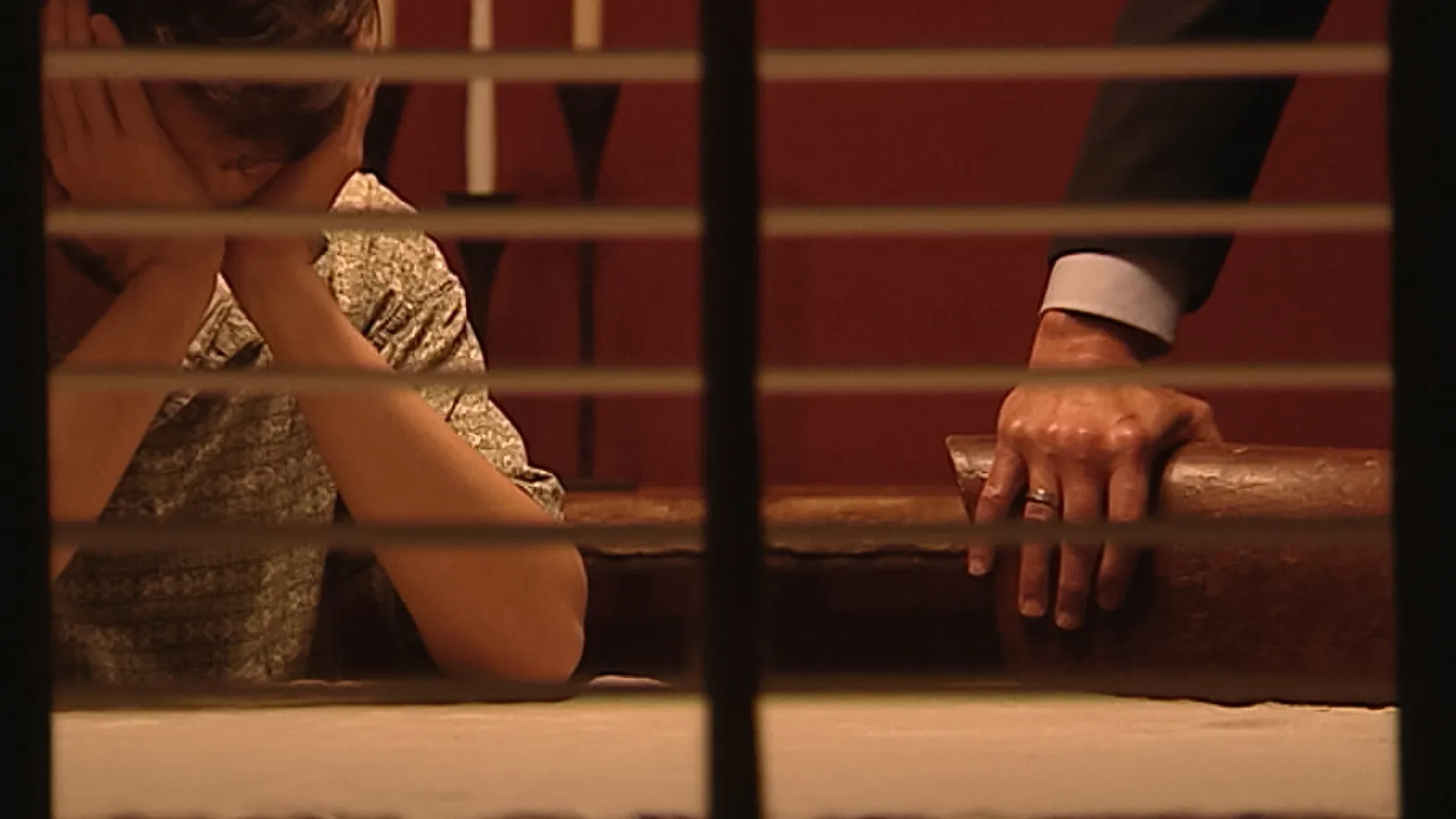
Documentary filmmaker David Osit was going down an internet rabbit hole in the late 2010s when he stumbled upon a primitive, yet quickly addictive, message board. Sporting the archaic look of a Web 1.0 site that time forgot, the still-active board, called “The Temple of TCAP,” featured sections with names like “Murder Police Interrogations” and “Re-Offenders.” Osit wasn’t a true-crime guy, even if a lot of the job offers he was getting were in the genre, given the public’s seemingly limitless appetite for it. Yet he found himself poring over criminal depositions, FOIA requests, and raw video footage of a TV series he used to watch regularly, but hadn’t seen in more than a decade: To Catch a Predator.
A Dateline NBC segment that ran from 2004 to 2007 and became a cultural juggernaut, To Catch a Predator found host Chris Hansen teaming up with law enforcement and a group of digital vigilantes named Perverted Justice to confront alleged child sexual predators. Its episodes were as salacious and riveting as they were nauseating and disquieting. Jimmy Kimmel once called it “Punk’d for pedophiles.”
Now, the show gets a fresh examination in Osit’s film Predators (currently in theaters in limited release), which was one of the most talked-about entries at this year’s Sundance Film Festival. As entertaining and uncomfortable as the TV show it explores, the documentary is the culmination of, as Osit puts it in the film, his “lifelong quest to understand how someone could [sexually abuse a child]. And partly what drew me to the show when I was young was [when] Chris would ask [the predators]: ‘Help me understand.’ But the show never really answered that question for me. I don’t think it was ever really interested in the answer.”
Osit looks for answers in multiple places, interviewing law enforcement officials and district attorneys, academics, and former Perverted Justice decoys from the show. The three-part film chronicles TCAP’s massive rise and tragic fall — one suspected predator killed himself after law enforcement and the production team approached his home, effectively ending the show — before scrutinizing the current crop of online vigilantes and ending with a look into Hansen’s mini-empire of true-crime dominance.
Editor’s picks
Though it may feel like To Catch a Predator ran hundreds of segments — a testament to its enduring appeal — the original iteration only featured 20 episodes. Yet the show lives on via countless memes, Reddit threads, YouTube clips, and online Hansen wannabes. Hansen’s go-to lines, like “Why don’t you have a seat,” “I was looking through the transcripts,” and “You see how this looks?” remain catchphrases to this day, as he continues to report on child exploitation and sexual abuse.
Watching To Catch a Predator “uncritically” in college, Osit tells Rolling Stone, “felt like this dirty, dark secret.” Osit says virtually all of his peers “had some illicit chat with somebody in a chat room or [had] been talked to by some lecherous person. But we were just like, ‘The internet is creepy, what can I tell you?’” But when the show turned that experience into entertainment, he says, “that was really hard to quantify and qualify in terms of how it made us feel. I watched it in my dorm room with fascination and this mix of schadenfreude, discomfort, and delight in weird proportions.”
Because the show was “edited a little bit like a dark comedy and a little bit like journalism,” Osit says, it complicated his own feelings about these types of incidents. ”I started to realize that we all were watching this stuff with our own trappings of what we think is right and wrong or what we think is OK and not OK to be televised and what makes us comfortable or uncomfortable. And I thought, ‘What if I could make a movie out of that?’”
Related Content
The “rules of the game” in true crime, Osit says, dictate that the audience is always expecting there to be an answer. “With true-crime, there’s going to be a bad guy and a good guy and someone to blame at the end,” Osit says. “[But] those answers aren’t easily forthcoming in the real world. We don’t live in a true-crime world. Villains aren’t just villains. Good guys aren’t just good guys … [I wanted] to interrogate the idea of what is a bad guy in the first place.”
The documentary dissects difficult, yet crucial questions around the idea of radical empathy: Does everyone deserve it, even a child predator? If so, how much? Are the lines between good and bad as clear-cut as we think? The subjects are men who travel to ostensibly engage in sexual acts with minors that no one could, would, or should justify. Yet To Catch a Predator itself has long been criticized by some for entrapment-style tactics, vigilante justice, the blurry line between law enforcement and journalism, and, most importantly to Osit, questions on whether the punishment for some offenders fits the crime.
“I would never make a film that’s trying to defend criminals or child predators,” Osit says. “I’m asking how does our society treat people at the bottom, whether that’s child predators or the prey.”
The film concludes with a gripping interview with Hansen, the Emmy-winning charismatic face of the show who has built a cottage industry out of Predator and its spinoffs. He starred in the similar Hansen vs. Predator and Takedown With Chris Hansen, co-founded the true-crime streaming service TruBlu in 2020, and hosts the podcasts Have a Seat With Chris Hansen and Predators I’ve Caught.
Calling TCAP “the origin story for modern true crime,” Osit tells Rolling Stone he views Hansen as a “founding father of this type of journalism.” But the filmmaker isn’t afraid to challenge Hansen on To Catch a Predator’s efficacy and long-term impact on society (especially when Predators takes a deeply personal turn).
Hansen tells Rolling Stone he’s approached all the time to do film and TV projects and typically declines, but he uniquely connected with Osit. “Through the course of several conversations with David, I felt that he had intellectual integrity. He’s an honest and smart guy.” He agreed to participate early on in the film’s development. “I had no feeling of authenticity or sincerity [with other people],” Hansen adds. “And I did with David. He was a good filmmaker and a good man who was going to maybe not do everything I would agree with, but I think it would be a fair and honest look at it.”
Hansen’s views on predators have evolved since the TCAP heyday. While he advocates for probation for some first-time offenders, he now also supports the death penalty for certain “hardcore habitual criminals who’ve actually offended.” The range of perpetrators and their deserving punishment, he says, has always been a gray area. “I don’t pretend to have the answers,” he says.
“When David says each one needs to be treated with dignity and respect, even if they’re bad predators, I think each case needs to be treated with intellectual integrity and some time as to how do we deal with each of these individuals,” Hansen says. “And maybe it is an impossible task … I think you can have deterrence, awareness, dialogue, and serve justice [in the same show].”
And there’s the rub that Predators so deftly explores. The series taught millions of parents the tactics some men used to prey on minors online. Yet as noted in a 2007 Rolling Stone feature on the series, “By whipping up public frenzy about online strangers, Perverted Justice diverts attention from the much more common source of child sex abuse: relatives and acquaintances. According to the Bureau of Justice Statistics, ninety-three percent of perpetrators of child sexual abuse are known to the child.”
Watching To Catch a Predator and its spinoffs, Osit found himself disconcerted by how they “use the same size bludgeon for any evil” — the idea that the 18-year-old who gets arrested and shamed for dating a 15-year-old, as happens in one of the newer shows, is treated in a similar manner to a 55-year-old creeping on a preteen. (That idea provides one of the film’s most telling moments in Hansen’s civil, albeit tense interview.)
Yet Osit points the finger as much at himself and the rest of us as at To Catch a Predator itself. (There’s a reason, after all, the film is called Predators, plural.) Why do we instinctively laugh as much as get repulsed at some of Hansen’s interviews or the chat logs? Where is the line between legitimate justice and lurid entertainment? Is it, as Osit asks in the film, “even possible for something designed as entertainment to be a public service?”
Trending Stories
“We built the show. We made the show popular,“ says Osit. “The show is not the cancer. It’s just giving us what we’ve always wanted, which is answers to hard questions. We created the problem and the show tries to give us a boogeyman, and it doesn’t work that way.
“The entire film is a Rorschach test,” he adds. “It’s not me testing you. It’s a test for yourself, and you can choose to take it or not when you watch. Some people don’t want to.”



